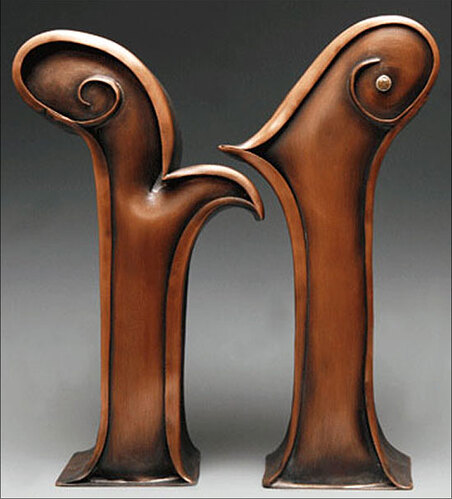Materials: Copper, Silver, 22K gold, brown diamond
Dimensions: 3 x 10 x 11"
I have designed crowns to reflect the bold new direction taken by the Women’s Torah Project, which opens the door for women to break the time-honored tradition that allows only men to scribe the Torah.
These Torah adornments combine the best of tradition, starting with the pomegranate, the sacred Shiv’at Ha-Minim mentioned in Exodus as the symbol of both righteousness and fruitfulness, here shown in warm earth tone materials - copper and a brown diamond, accented with silver and 22k gold. At the same time I have created a clean, purposeful and sculptural design which is intentionally contemporary and reflective of the dialogue evoked by the Project.
In my own life, as a grandchild of Holocaust survivors, and full time metal artist, I have devoted my artistic career to making Judaica that will preserve, illuminate and share Jewish traditions while honoring women building pathways to new and exciting futures.
Photo credit: Dan Casella
Aimee Golant
San Francisco, CA. USA
As a granddaughter of Holocaust survivors and a sixth generation metalsmith, Aimee Golant creates ritual objects to enhance spiritual traditions, ?while preserving, illuminating ?and sharing the universal ?within Judaism. She studied metal arts at San Francisco State University, while majoring in Sociology. Aimee Golant was voted Best Jewish Artisan Craftsperson in San Francisco 2010 & 2011 by the readers of the J. Jewish News Weekly. Some of Aimee Golant’s notable artistic projects include: creating the crown for the Women’s Torah Project, creating mezuzot for two Space Shuttle missions, and for the National Museum of American Jewish History in Philadelphia. Her art has helped raise money for such charitable organizations as Hadassah, and Shalom Bayit. She founded the Metal Art program at the San Francisco Waldorf High School in 2005, where she still teaches classical metalsmithing. She also teaches metal craft at The Crucible in Oakland, California, and at Sa n Francisco’s Scintillant Studio. Aimee lives in San Francisco with her husband David Casella and son Kaleb.
These containers and vessels definitely hold their place in the world of stunning art objects as well as in the world of metalsmithing.
Since the dawn of time humans have created containers to hold things that were important to them, from large vessels to hold food and harvests to intimate containers for small precious things. They might hold memories, ashes, medicine, beverage, fruit or food - but all spring from the imagination and skill of the maker. Some have specific religious functions, some are meant for everyday use. When one thinks of a vessel or container the inclination is to think of something with solid walls - yet many of these works involve the exploration of positive and negative space, and the use of negative space to help create the illusion of the wall of the vessel.
As the world’s largest jewelry related internet site, Ganoksin strives to develop exhibitions showcasing work from around the world. This exhibition was open to all metalsmiths, professional and amateur, advanced and beginner. Participants are from The Netherlands, the USA, Canada, Australia, Costa Rica, the United Kingdom, Israel, Hong Kong, Colombia, Romania, Italy, Ireland, Japan, Malaysia and Denmark. While most of the pieces are by an individual metalsmith, some are collaborations, one of three artists spanning 50 years.
In total 319 artists contributed 729 show pieces for the permanent online exhibition.
Objects in the exhibition include boxes, lockets, urns, ash containers, bowls, wine cups, reliquaries, match holders, vases, teapots, pitchers, sugar bowls, baskets, nests, pillboxes, clutches and a range of sculptural forms. A variety of techniques are showcased covering a wide range of metalsmithing techniques. Materials used include everything from gold and silver to less expensive metals. Ornamentation includes the addition of enamel, chasing and repousse’, gemstones and found objects.
The exhibition was curated by Beth Wicker, President of the North Carolina Society of Goldsmiths in the United States, and Adjunct Instructor at Northeastern Technical College in South Carolina. Director of the exhibition is Hanuman Aspler, founder of The Ganoksin Project, the world’s largest internet jewelry site.
